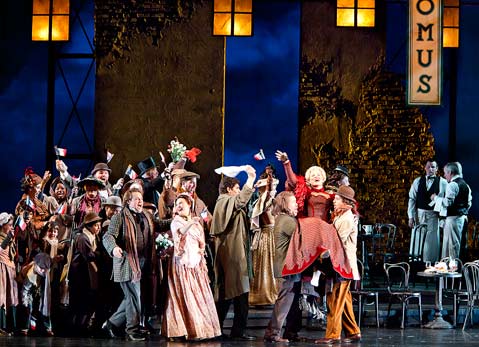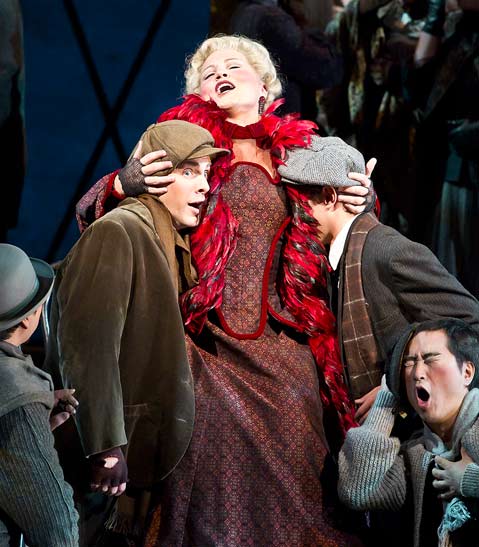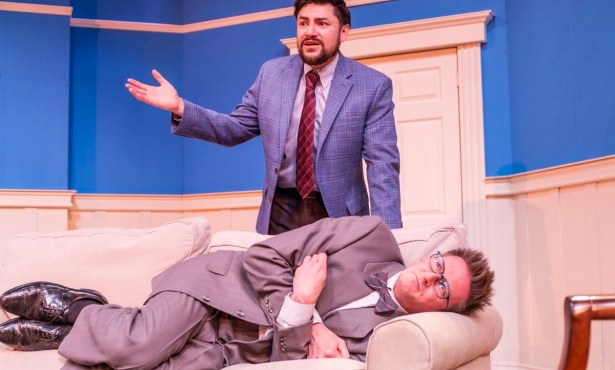La bohème at the Granada
Rebecca Davis, Christopher Bengochea Shine in Puccini Classic

For an opera that centers on doomed love amid brutal poverty, La bohème gains a lot of resonance from being set during the holiday season. On Sunday at the Granada, the curtain opened on a beautiful (if desolate) set without a sprig of mistletoe or a wreath of holly in sight, yet it was easy to tell from the way that Steven LaBrie entered as Schaunard, the young musician whose windfall employment buys the group some wine, that whatever came their way would be pooled in the generous spirit of Christmas Eve, circa 1830. The story’s consumptive heroine Mimì, wonderfully sung and acted by Rebecca Davis, may not come down the chimney like old Saint Nick, but to her neighbor Rodolfo (Christopher Bengochea), she is just the kind of Christmas present he’s been dreaming of.
Each of the four acts of La bohème resembles a lyric poem, with seemingly discordant or opposing elements that coalesce into a single unified sense of deeper meaning. In Act One, the boisterous camaraderie of the garret crew of Marcello (Malcolm Mackenzie), Colline (Gabriel Vamvulescu), and Schaunard sets one tone when they run psychological circles around the landlord Benoit (Jesse Merlin) in order to avoid paying rent. But the intense vulnerability of Mimì, who enters immediately after the gang leaves and who bears the story’s most powerful symbol, the unlit candle, gets amplified by Rodolfo, who tricks her into sticking around and then pours out his heart in an outstanding aria. The yin and yang of these two elements — raucous irresponsibility and tender isolation — are what make the whole act work, and in this production they meshed seamlessly.

Act Two belongs to the charismatic and mischievous Musetta, played and sung with charm and abandon by Jan Cornelius. She so completely dominates the bustling Café Momus sequence that it would be easy to overlook the splendid work done by the others — Mackenzie in particular, but also the entire chorus, including Ernest Alvarez as the festive Parpignol. Again, it is precisely the degree to which Musetta’s singularity is complemented by the enthusiasm of the group that gives the scene its resonance. Cornelius had the Granada audience alternately appalled and delighted with her pranks until finally it felt as though they would be as willing as the characters onstage to carry her off in a grand procession.
When Act Three opens on the snowy outskirts of Paris, the holiday theme expands into a full-on “blue Christmas.” Mimì, exhausted from her illness and bereft of her lover, enters calling on Marcello, only to be held off to the side in hiding as she overhears Rodolfo express his determination to throw her over. The pretext of jealousy in Rodolfo’s rationale, which is poetically shadowed and contrasted with Musetta’s offstage volatility, gives way to the subtext of death, the suitor he really fears. The duet Mimì and Rodolfo sing to end this act, in which they pledge to stay together until spring, must be one of opera’s most bittersweet moments.
When spring does arrive in Act Four, it is hardly the cure-all that was hoped for back when the snow was on the ground. Colline has a great little song in this act that works in microcosm as a symbol of all that has come before, and when Musetta implores the Virgin Mary on behalf of the dying Mimì, the irony only increases the sense that these highly secular people are leading lives of sacramental beauty



